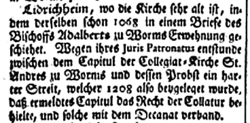Nonnenhof (Bobenheim-Roxheim)
| Nunnery | ||
|---|---|---|
 Entry on Littersheim or Nonnenhof, in Johann Heinrich Zedler's Great Complete Universal Lexicon of All Sciences and Arts , Volume 59, 1749 |
||
| Data | ||
| place | Bobenheim-Roxheim | |
| Builder | Family Heyl zu Herrnsheim | |
| Architectural style | two and a half storey hipped roof building, cellar: baroque | |
| Construction year | second half of the 19th century | |
| Coordinates | 49 ° 35 '44 " N , 8 ° 22' 10.8" E | |
|
|
||
The Nonnenhof (also Littersheimer Hof ) is an estate near Bobenheim-Roxheim .
Location and history
The estate is located in a remote location northeast of the Bobenheim district . It goes back to the submerged place Littersheim , which was there earlier on an old Rhine arm , in which the Eckbach flows today .
The name Nonnenhof comes from the fact that the settlement had belonged to the Maria Münster nunnery in Worms as an economic asset since the Middle Ages . In 1141 the Bishop of Worms Burchard II confirmed to this convent his property rights there from 1067, consisting of four courts with ten associated unfree courts. Apparently the Littersheim property already belonged to the monastery foundation in the 9th century, because the ownership rights described in 1067 refer to alleged donations by the alleged monastery founder, Emperor Ludwig the Pious . The conditions documented in the description of the property of 1067 that the monastic residents of Littersheim had to carry out labor to preserve the walls of Ladenburg and the Fliehburg Deidesheim point in this direction, because both beneficiaries were former imperial estates.
At the same time, the Weissenburg Abbey in Littersheim was very wealthy, the property of which fell to Duke Otto I in 985, in the so-called Salian church robbery , and later came to the Worms Monastery. Maria Münster Monastery was also able to acquire these property shares by the end of the 13th century. With this originally Weißenburg part, the right of patronage of the Littersheim church came to the diocese of Worms . Bishop Adalbert II donated some of it to the Andreasstift Worms in 1068 ; under Bishop Burchard II, the Andreasstift appears as the sole church owner in 1141 and remained there until secularization under the French occupation in 1803.
The location of this former church is indicated by the field name Kirchgewann . It was consecrated to St. Laurentius , which is why this saint was later included in the local coat of arms of Bobenheim. The old church patronage was also transferred to Bobenheim. It was renovated several times (the last time in 1768), profaned during the secularization and still stood as a barn until after 1870. It burned down due to a lightning strike and finally disappeared completely, as did the surrounding cemetery, on which there were still 8 old tombstones at that time. To save the historical building, the cath. Parish Roxheim in 1858 a request for repurchase to the then owner Christian Scholz in Mainz , but remained unsuccessful.
Current building stock
The farm is a monument on the list of cultural monuments in Bobenheim-Roxheim . It is an elongated square with servants' house, stables and barns, as well as the manor house, a two-and-a-half-storey hipped roof building from the 19th century with a baroque cellar.
The property has been owned by the Heyl zu Herrnsheim industrialist family from Worms since 1868 .
literature
- Georg Biundo : Bobenheim-Roxheim: history of a large community. Municipal administration Bobenheim-Roxheim, 1973, pp. 433–459.
- Rainer Joha Bender: Landeskundlicher Excursionsführer Pfalz , self-published by the Geographical Institute of the University of Mannheim, 1989, p. 202, ISBN 3923750242 ; (Detail scan)
- Michael Frey : Attempt of a geographical-historical-statistical description of the royal Bavarian Rhine district , Volume 2, p. 242 u. 243, Speyer, 1836; (Digital scan)
- Jörg Fesser: Early Middle Ages Settlements in the Northern Front Palatinate with Special Consideration of the Merovingian Age Findings and the Carolingian Age Written Sources , Diss. Phil., Mannheim 2006, pp. 624–627; PDF view
Web links
Individual evidence
- ↑ Lutz Fenske: The German Royal Palaces , Volume 3, p. 338 u. 340, and 350, Verlag Vandenhoeck & Ruprecht, 1997, ISBN 3525365101 ; (Digital scan 1) (Digital scan 2)
- ^ Michael Matheus : City and Defense in the Middle Rhine Region , Verlag Franz Steiner, 2003, p. 32, ISBN 351508228X ; (Digital scan)
- ^ Alexander Antonow: Planning and building castles in southern Germany , 1983, p. 29, ISBN 3924086044 ; (Detail scan)
- ↑ Journal for the History of the Upper Rhine , Volume 114, 1966, p. 16; (Detail scan)
- ↑ Klemens Stadler: Deutsche Wappen , Volume 2, p. 19, Angelsachsen-Verlag, 1966, (detail scan)
- ↑ Georg Biundo: Bobenheim-Roxheim: History of a large community , municipal administration Bobenheim-Roxheim, 1973, p. 456
